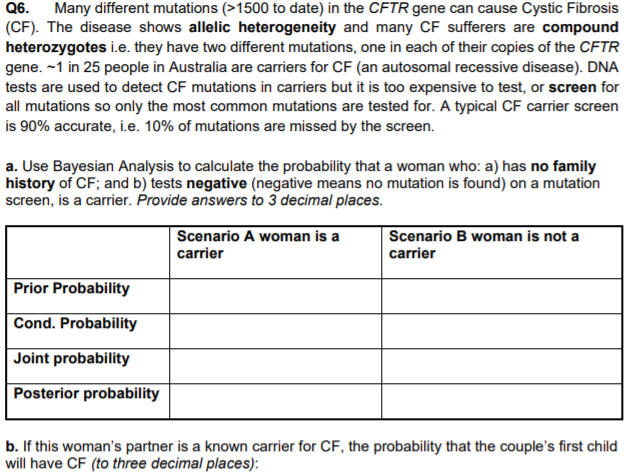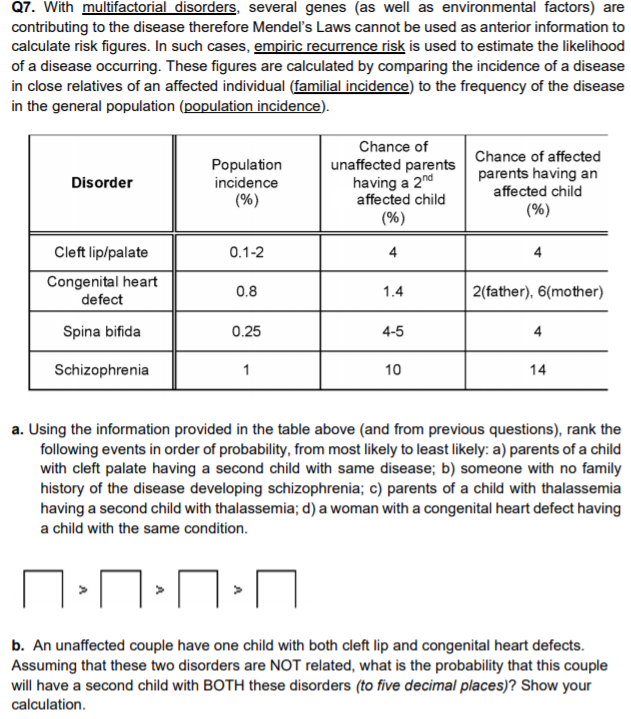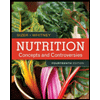26. Many different mutations (>1500 to date) in the CFTR gene can cause Cystic Fibrosis (CF). The disease shows allelic heterogeneity and many CF sufferers are compound heterozygotes i.e. they have two different mutations, one in each of their copies of the CFTR gene. -1 in 25 people in Australia are carriers for CF (an autosomal recessive disease). DNA ests are used to detect CF mutations in carriers but it is too expensive to test, or screen for all mutations so only the most common mutations are tested for. A typical CF carrier screen s 90% accurate, i.e. 10% of mutations are missed by the screen. a. Use Bayesian Analysis to calculate the probability that a woman who: a) has no family history of CF; and b) tests negative (negative means no mutation is found) on a mutation screen, is a carrier. Provide answers to 3 decimal places. Scenario A woman is a carrier Scenario B woman is not a carrier Prior Probability Cond. Probability Joint probability Posterior probability b. If this woman's partner is a known carrier for CF, the probability that the couple's first child will have CF (to three decimal places):
26. Many different mutations (>1500 to date) in the CFTR gene can cause Cystic Fibrosis (CF). The disease shows allelic heterogeneity and many CF sufferers are compound heterozygotes i.e. they have two different mutations, one in each of their copies of the CFTR gene. -1 in 25 people in Australia are carriers for CF (an autosomal recessive disease). DNA ests are used to detect CF mutations in carriers but it is too expensive to test, or screen for all mutations so only the most common mutations are tested for. A typical CF carrier screen s 90% accurate, i.e. 10% of mutations are missed by the screen. a. Use Bayesian Analysis to calculate the probability that a woman who: a) has no family history of CF; and b) tests negative (negative means no mutation is found) on a mutation screen, is a carrier. Provide answers to 3 decimal places. Scenario A woman is a carrier Scenario B woman is not a carrier Prior Probability Cond. Probability Joint probability Posterior probability b. If this woman's partner is a known carrier for CF, the probability that the couple's first child will have CF (to three decimal places):
Biology 2e
2nd Edition
ISBN:9781947172517
Author:Matthew Douglas, Jung Choi, Mary Ann Clark
Publisher:Matthew Douglas, Jung Choi, Mary Ann Clark
Chapter12: Mendel's Experiments And Heredity
Section: Chapter Questions
Problem 13RQ: The ABO blood groups in humans are expressed as the IAlB, and IAalleles. The allele encodes the A...
Related questions
Topic Video
Question

Transcribed Image Text:Q6. Many different mutations (>1500 to date) in the CFTR gene can cause Cystic Fibrosis
(CF). The disease shows allelic heterogeneity and many CF sufferers are compound
heterozygotes i.e. they have two different mutations, one in each of their copies of the CFTR
gene. ~1 in 25 people in Australia are carriers for CF (an autosomal recessive disease). DNA
tests are used to detect CF mutations in carriers but it is too expensive to test, or screen for
all mutations so only the most common mutations are tested for. A typical CF carrier screen
is 90% accurate, i.e. 10% of mutations are missed by the screen.
a. Use Bayesian Analysis to calculate the probability that a woman who: a) has no family
history of CF; and b) tests negative (negative means no mutation is found) on a mutation
screen, is a carrier. Provide answers to 3 decimal places.
Scenario A woman is a
Scenario B woman is not a
carrier
carrier
Prior Probability
Cond. Probability
Joint probability
Posterior probability
b. If this woman's partner is a known carrier for CF, the probability that the couple's first child
will have CF (to three decimal places):

Transcribed Image Text:Q7. With multifactorial disorders, several genes (as well as environmental factors) are
contributing to the disease therefore Mendel's Laws cannot be used as anterior information to
calculate risk figures. In such cases, empiric recurrence risk is used to estimate the likelihood
of a disease occurring. These figures are calculated by comparing the incidence of a disease
in close relatives of an affected individual (familial incidence) to the frequency of the disease
in the general population (population incidence).
Chance of
Chance of affected
Population
incidence
unaffected parents
having a 2nd
affected child
parents having an
affected child
(%)
Disorder
(%)
(%)
Cleft lip/palate
0.1-2
4
Congenital heart
0.8
1.4
2(father), 6(mother)
defect
Spina bifida
0.25
4-5
4
Schizophrenia
10
14
a. Using the information provided in the table above (and from previous questions), rank the
following events in order of probability, from most likely to least likely: a) parents of a child
with cleft palate having a second child with same disease; b) someone with no family
history of the disease developing schizophrenia; c) parents of a child with thalassemia
having a second child with thalassemia; d) a woman with a congenital heart defect having
a child with the same condition.
b. An unaffected couple have one child with both cleft lip and congenital heart defects.
Assuming that these two disorders are NOT related, what is the probability that this couple
will have a second child with BOTH these disorders (to five decimal places)? Show your
calculation.
Expert Solution
This question has been solved!
Explore an expertly crafted, step-by-step solution for a thorough understanding of key concepts.
This is a popular solution!
Trending now
This is a popular solution!
Step by step
Solved in 3 steps with 1 images

Knowledge Booster
Learn more about
Need a deep-dive on the concept behind this application? Look no further. Learn more about this topic, biology and related others by exploring similar questions and additional content below.Recommended textbooks for you

Biology 2e
Biology
ISBN:
9781947172517
Author:
Matthew Douglas, Jung Choi, Mary Ann Clark
Publisher:
OpenStax

Biology (MindTap Course List)
Biology
ISBN:
9781337392938
Author:
Eldra Solomon, Charles Martin, Diana W. Martin, Linda R. Berg
Publisher:
Cengage Learning

Biology: The Unity and Diversity of Life (MindTap…
Biology
ISBN:
9781337408332
Author:
Cecie Starr, Ralph Taggart, Christine Evers, Lisa Starr
Publisher:
Cengage Learning

Biology 2e
Biology
ISBN:
9781947172517
Author:
Matthew Douglas, Jung Choi, Mary Ann Clark
Publisher:
OpenStax

Biology (MindTap Course List)
Biology
ISBN:
9781337392938
Author:
Eldra Solomon, Charles Martin, Diana W. Martin, Linda R. Berg
Publisher:
Cengage Learning

Biology: The Unity and Diversity of Life (MindTap…
Biology
ISBN:
9781337408332
Author:
Cecie Starr, Ralph Taggart, Christine Evers, Lisa Starr
Publisher:
Cengage Learning

Biology Today and Tomorrow without Physiology (Mi…
Biology
ISBN:
9781305117396
Author:
Cecie Starr, Christine Evers, Lisa Starr
Publisher:
Cengage Learning

Nutrition: Concepts and Controversies - Standalo…
Health & Nutrition
ISBN:
9781305627994
Author:
Frances Sizer, Ellie Whitney
Publisher:
Brooks Cole